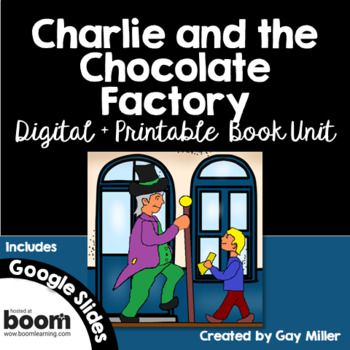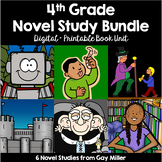Charlie and the Chocolate Factory Novel Study: Digital + Printable Book Unit
- PDF
- Google Apps™
- Internet Activities

What educators are saying
Also included in
- Are you looking for some all-in-one novel studies with a chocolate theme? Look no further. These comprehensive units include vocabulary, comprehension questions, constructed response questions, and skill lessons. This bundle includes 4 novel studies aligned with the Common Core Standards for gradesPrice $15.00Original Price $27.50Save $12.50
- Roald Dahl is one of the most loved children’s authors. Save by purchasing six book units based on Dahl’s work in this one bundle. Books in this series include:+ Charlie and the Chocolate Factory + Fantastic Mr. Fox + The BFG + James and the Giant Peach + The Witches + Matilda Because each of thesePrice $40.00Original Price $56.50Save $16.50
- Save by purchasing these 4th Grade Reading Level Book Units in a bundle. These units are aligned with the Common Core State Standards. Each book unit contains the following:✨ DIGITAL RESOURCESThis novel study includes links to digital resources. Boom Learning is used for multiple-choice, short ansPrice $42.00Original Price $56.50Save $14.50
Description
Are you looking for an all-in-one novel study for Charlie and the Chocolate Factory? Look no further. This comprehensive unit includes vocabulary, comprehension questions, constructed response questions, and grammar lessons aligned to the Common Core Standards for grades 4-5.
✨ DIGITAL RESOURCES
This novel study includes links to digital resources. Boom Learning is used for multiple-choice, short-answer, and fill-in-the-blank questions such as comprehension questions and vocabulary practice.
Activities that require more open-ended responses may be found in Google Slides. This includes all the writing prompts with organizers for students to plan responses.
✏️ PRINTABLE RESOURCES
Lesson Plans at a Glance
Vocabulary
- Vocabulary, including definitions and sample sentences from the text
- Vocabulary Test
Comprehension & Writing
Ten comprehension quizzes (one for every three chapters of the book) are included, containing:
- multiple-choice questions require students to recall details from the chapters
- multiple-choice higher-level thinking questions include sequencing, main idea, plot development, summary, drawing conclusions, inference, predicting, theme, understanding vocabulary, interpreting literary devices, etc.
Each chapter contains one constructed response question. Most of these have a graphic organizer to help students organize and plan a response.
Activities to Do with the Book
- Candy Bar Favorites
- Golden Ticket
- Character Activities
- Candy Bar Inventions
- Oompa Loompa Boat
Grammar Unit (Each lesson contains several organizers, which can be made into a grammar lapbook and practice activities.)
- Recognizing Nouns, Abstract or Concrete Nouns, Common or Proper Nouns, and Capitalizing Titles
- Forming Plural and Possessive Nouns
- Forms of Be, Linking Verbs, and Action or State of Being Verbs
- Frequently Confused Words
- Helping Verbs and Verb Tenses
- Irregular Verbs
- Sit/Set, Rise/Raise, Lie/Lay
- Subject-Verb Agreement and Modal Auxiliaries
- Pronouns
- Relative Pronouns
- Adjectives
- Ordering Adjectives
- Adverbs
- Relative Adverbs
- Conjunctions
- Interjections
- Prepositions
Answer keys for each practice page are included.
Please download the preview for a closer look.
°*”˜˜”*°•.¸☆*”˜˜”*°•.¸☆ ★ ☆¸.•°*”˜˜”*°•.¸☆*”˜˜”*°
Boom Cards live in the cloud. They can't be printed. They play on most modern browsers, Android, iPads, iPhones, and Kindle Fires. You open a Boom Learning account to play them (to protect the children). Create Fast Play pins to assign your Boom Cards to students.
Boom Learning also has premium accounts. Premium accounts offer advanced assignment tools, individual and whole class performance tracking, and more. If you are a new Boom Learning customer, when you redeem your Boom Cards purchase you get 90-day free trial of a premium account. When your trial ends, you can renew or move to a free account. You may upgrade, downgrade or cancel at any time. Free accounts use purchased Boom Cards with Fast Play pins.
°*”˜˜”*°•.¸☆*”˜˜”*°•.¸☆ ★ ☆¸.•°*”˜˜”*°•.¸☆*”˜˜”*°
If you want additional book units, click here for a list of ★available titles.








